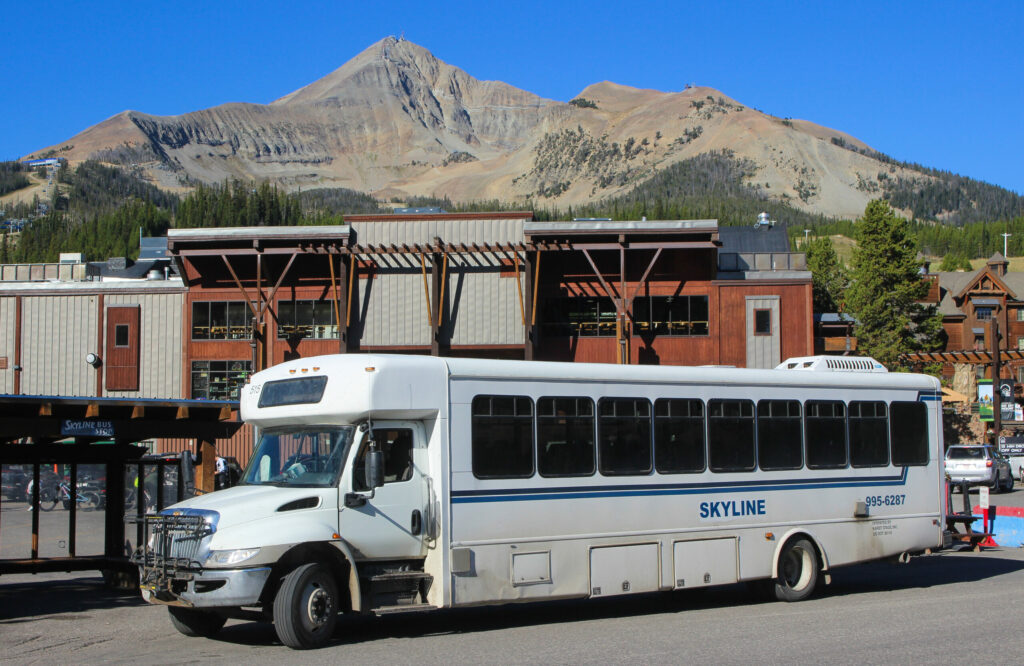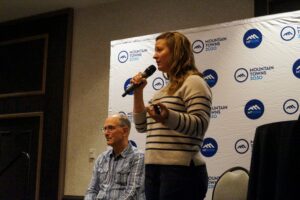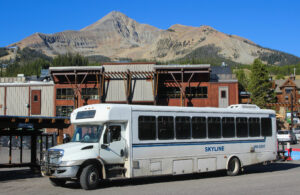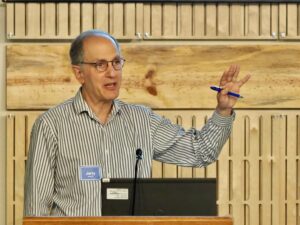
Skyline Bus offers free service across Big Sky during peak seasons. Skyline also offers a low-fare, “Link” service between Bozeman and Big Sky. PHOTO BY JACK REANEY
By Jerry Tinianow

If you want to visit Big Sky, Montana, you need a car. Same deal if you want to work or live there. Right?
That conventional wisdom led me to book a car at the Bozeman airport when I scheduled a visit to Big Sky in August 2023. It was total knee-jerk: Book flight, rent car, move on.
But then I reconsidered. I was coming to help Big Sky Sustainability Network Organization (SNO) implement its new climate action plan. Part of the plan calls for reducing greenhouse gas emissions from vehicles. That’s a big part of climate action plans everywhere. How could I advise the community to get people out of cars if the first thing I did upon arrival was to get into one?
So I explored my options. There weren’t many. There is no regular transit service between the Bozeman airport and Big Sky. The few shuttle services are expensive and operate infrequently. There is a free bus service inside Big Sky, which offers a new on-demand, app-based microtransit service, but first you have to get up to Big Sky. “Big Sky without a car” was a black box.
I bit the bullet and booked a shuttle from the airport, specifically the Shuttle to Big Sky (SBS). For $176 including driver gratuity, they would pick me up at 7 p.m. and take me to my hotel in Big Sky—about an hour away.
It was a bit risky. Their shuttles operate hourly. The last one leaves the airport at 8 p.m. My flight was scheduled to arrive at 5:45. If it was late and I missed that last shuttle, I wasn’t sure how I would get to Big Sky.
Fortunately, my flight was on time. Even better, upon arrival I got a pleasant surprise—a text from my driver, Jordan. She had been monitoring my flight and had no other passengers scheduled. She picked me up early. We had a pleasant ride down to Big Sky and a nice conversation about local conditions. You don’t get that if you drive by yourself.
I asked Jordan what would have happened if my flight had been late. She assured me that SBS doesn’t leave clients behind. They find a way to pick you up even if your flight is delayed. That was comforting, but that policy does not show up on their website. If you don’t know about it and you have a late flight, you might book a car to avoid the risk of a late arrival.
I ended up not needing to use the local transit in Big Sky. I carpooled with a colleague, Lizzie Peyton of Big Sky SNO, to our appointments. We scheduled meetings in Bozeman on the day of my departure. After they were over, she took me to the airport for my flight home.
If I had taken the shuttle both ways, it still would have cost me about $150 less than a car rental and gas. But what if a family of four had made the trip? The car would have cost the same, but the shuttle would have cost a lot more. How many families would make a big financial sacrifice just to reduce their carbon footprint?
Ski towns understand the threat that human-caused climate change poses to them. The snow and runoff they depend on for recreation and water are at risk. Many of those community members want to do their part to reduce greenhouse gas emissions. But solutions that help big cities reduce emissions from personal mobility—public transit, cycling and carpooling—are hard to implement in mountain towns.
Most of the year, there are more visitors in resort towns than residents. The visitors are comfortable using the mode they know—cars—rather than local transit and shuttle systems they don’t know and often don’t use at home. They also don’t come on vacation to get a lecture about climate change.
Last year, my company helped the town of Breckenridge, Colorado update its sustainability plan. Even though the State of Colorado offers an affordable bus service between downtown Denver and the nearby town of Frisco, Breckenridge still struggles to get visitors out of cars. There’s a free bus service between Frisco and Breckenridge, and free service in town, yet most visitors still prefer coming in a car they own or rent. Breckenridge is reconsidering its parking policies and looking for ways to enhance local transit services through more frequent and flexible routes.
I will be working with Big Sky SNO to find some solutions that will work in Big Sky. The community already has an online “One Less Car” program that helps people find the best routes for biking and walking, provides transit schedules and connects people with carpool partners. A true regional transit system that links all forms of shared mobility—buses, carpools, private shuttle systems, even school transportation—into a single integrated network could do even more.
Getting more electric vehicles on the road would also reduce emissions. The local electric utility, NorthWestern Energy, is already generating more than half its electricity from renewable sources. Electric vehicles don’t work as well in Montana winters, but if there were more electric rental cars and shuttles in the summer, emissions would be lower. Using low-carbon electricity is better than using high-carbon gasoline.
We don’t have to get everyone out of cars. We just need to motivate people to drive fewer miles, and use more efficient and electric vehicles for the miles they still need to drive. The solutions are out there.
Jerry Tinianow is the proprietor of WestUrb. He was Denver’s first chief sustainability officer. He began his career in sustainability in 1975 working in Washington, D.C. and Montana as a legislative aide to Montana Congressman Max Baucus. WestUrb will be working with Big Sky SNO to implement its climate action plan through June 2024.


